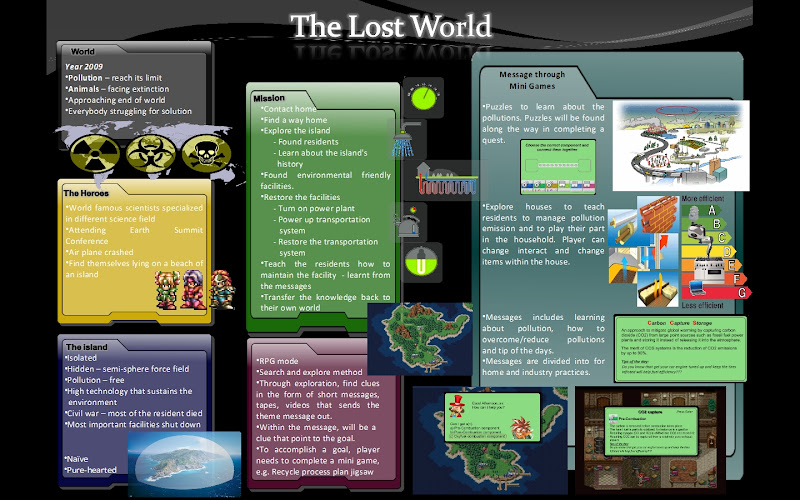For one of my modules for game architecture, there was an assignment for game design. Game design is basically to design the game in the sense of the game machanics (how the game is played), storyboard (the game's story line and flow), game message and mission. A part of this assignment was to design a game based on the Imagine Cup rules, regulation and theme. Also to create a playable verticle slice of the game.
My teammate and coursemate also did the same. We kindda merged our ideas and created team D&D (being our initials). Team D&D summited a game titled The Lost World.
The Story
The Lost World sets the world at the time where earth has gone through decades of revolution. However, human being who lives on this planet did not take a good care of their mother earth. In Year 2009, the pollution on this planet earth has reached its limit. It caused half of human population died. Besides, this bad environment has makes animals facing their extinction.
While most of the human being on Earth cares only their money and their entertainment, there are a bunch of people out there that really cares about their mother Earth. Ken, a world famous scientist who specialized in researching for methods to make the environment sustainable is attending Earth Summit Conference together with his researcher.
There is an isolated island that still keeping the beauty nature of this planet. It keeps hidden from the rest of the world by using a high-tech semi-sphere force field. This thanks to the scientists who live on this island. The technology and the attitude of the residents have made this island free from any kind of pollution. However, civil war has put them into trouble and caused most of the resident died.
The Game Design

My teammate and coursemate also did the same. We kindda merged our ideas and created team D&D (being our initials). Team D&D summited a game titled The Lost World.
The Story
The Lost World sets the world at the time where earth has gone through decades of revolution. However, human being who lives on this planet did not take a good care of their mother earth. In Year 2009, the pollution on this planet earth has reached its limit. It caused half of human population died. Besides, this bad environment has makes animals facing their extinction.
While most of the human being on Earth cares only their money and their entertainment, there are a bunch of people out there that really cares about their mother Earth. Ken, a world famous scientist who specialized in researching for methods to make the environment sustainable is attending Earth Summit Conference together with his researcher.
There is an isolated island that still keeping the beauty nature of this planet. It keeps hidden from the rest of the world by using a high-tech semi-sphere force field. This thanks to the scientists who live on this island. The technology and the attitude of the residents have made this island free from any kind of pollution. However, civil war has put them into trouble and caused most of the resident died.
The Game Design

